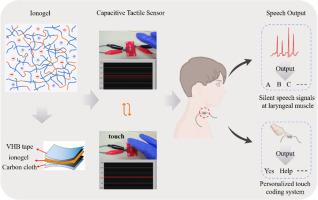Speech-assistive interfacing via a secondary-flow-induced ionogel
IF 7.1
Q1 ENGINEERING, CHEMICAL
引用次数: 0
Abstract
Impaired language function significantly restricts the communication ability and quality of life for aphasia patients. Even though current Human-Machine Interaction (HMI) system mainly relies on explicit signal, it is difficult to meet the demand for natural and real-time expression. To achieve the accurate recognition of non-speech intention, a highly sensitive capacitive sensor based on ionogel is proposed. An innovative dynamic polymerization strategy induced by secondary flow is designed to address the phase separation issue caused by incompatibility between ionic liquid (IL) and monomer. The method overcomes interfacial tension limitations, enabling uniform dispersion of monomer within IL and facilitating three-dimensional network construction. The resulting ionogel exhibits excellent mechanical properties (tensile strength of 50 kPa, elongation at break of 219 %), as well as high pressure sensitivity (0.042 kPa-1) and antibacterial properties, capable of detecting subtle tactile stimuli. This study offers critical material support for the development of non-speech interaction system of aphasia patients and provides a universal strategy for the construction of functional ionogels.

通过二次流诱导的离子凝胶实现语音辅助接口
语言功能障碍严重制约失语症患者的沟通能力和生活质量。当前的人机交互(HMI)系统主要依赖于显式信号,难以满足对自然、实时表达的需求。为了实现对非语音意图的准确识别,提出了一种基于离子凝胶的高灵敏度电容式传感器。为了解决离子液体与单体不相容导致的相分离问题,设计了一种创新的二次流诱导动态聚合策略。该方法克服了界面张力的限制,使单体在IL内均匀分散,有利于三维网络的构建。所得的离子凝胶具有优异的机械性能(抗拉强度为50 kPa,断裂伸长率为219%),以及高压力灵敏度(0.042 kPa-1)和抗菌性能,能够检测细微的触觉刺激。本研究为失语患者非言语互动系统的发展提供了重要的物质支持,并为功能电离层的构建提供了一种通用策略。
本文章由计算机程序翻译,如有差异,请以英文原文为准。
求助全文
约1分钟内获得全文
求助全文
来源期刊

Chemical Engineering Journal Advances
Engineering-Industrial and Manufacturing Engineering
CiteScore
8.30
自引率
0.00%
发文量
213
审稿时长
26 days
 求助内容:
求助内容: 应助结果提醒方式:
应助结果提醒方式:


